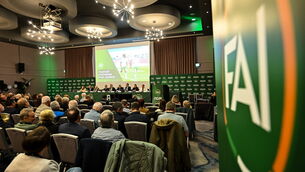When enough is enough: How much more can Irish players take?

From a purist’s perspective, I have enjoyed all five contests attended, but I can fully understand the view being expressed by a wide section of rugby supporters that, in the wake of the recent World Cup, this season’s Six Nations championship has been turgid, uninspiring, and short on class. Alas, last season’s tournament-defining final day of spectacular running and continuity on Super Saturday is but a distant memory.
The fact that a clean sweep of southern hemisphere sides occupied all semi-final slots at last autumn’s World Cup served to highlight once again the different approaches to the way rugby is contested in this part of the world.
Dull, boring, collision-based contests is the constant stick used to beat the type of rugby played in the Six Nations tournament and on the basis of what I have witnessed so far, it’s difficult to argue with that assessment, even if I have always contended that there are many different ways to play the game. There is no shame in a side playing in a manner that best fits the skill set of its players.
Therein lies the biggest challenge for northern hemisphere teams. If you want to seriously contend for the biggest prize in the game — the Webb Ellis trophy — then it is imperative that you improve that skill set and seek to broaden the options in terms of approach.
What New Zealand, Australia, and latterly Argentina have shown is that, even when they are being put under sustained periods of set-piece and breakdown pressure from the more collision-based European sides, they have the evasion skills and awareness of how to create space. They look at the most organised of defensive systems and find the potential point of vulnerability that every system has.
Almost unnoticed, a new season of Super Rugby kicked off last weekend, a revolutionary one in many respects.
Even though the tournament has continually evolved since its introduction 20 years ago, it was always the sole preserve of teams from New Zealand, Australia, and South Africa.
Last Saturday, however, saw the historic inclusion of teams from Argentina and Japan for the first time when the Jaguars of Argentina launched their campaign with an historic 34-33 win in a cracker of a game over the Cheetahs in a hot-bed of South African rugby in Bloemfontein.
While the Sunwolves from Japan lost their inaugural fixture by double scores — 26-13 against Transvaal’s Lions in Tokyo — it nevertheless launched a historic day for Japanese rugby as they build towards hosting the next World Cup in 2019.
Ireland witnessed first hand the spectacular improvement in skill levels and playing style of Argentina that has coincided with their inclusion in the southern hemispheres equivalent of our Six Nations, the Rugby Championship. Harsh lessons were absorbed along the way but regular test exposure to the SANZAR nations brought the Pumas on in leaps and bounds.
Now, for the first time since the advent of professionalism, there is a home-based outlet for Puma players to earn a good living and expand their rugby horizons beyond heading to Europe. That has the capacity to improve their national side even more.
Likewise Japan. In what proved a captivating World Cup, the highlight across the board was Japan’s seismic win over two-time world champions South Africa on the opening weekend. That was not a one-off performance and with a more forgiving fixture schedule, Japan would have made the quarter-finals. As it was, they were the first country in World Cup history to be denied a quarter-final appearance after winning three of their four pool matches.
The big question now is what will the inclusion of a Japanese franchise in the top echelon of southern hemisphere club rugby do for their national side? Surely the type of exposure their top internationals are now going to experience on a weekly basis will improve their overall game?
While the Sunwolves are likely to be on the receiving end of some hammerings over the next few months, it is bound to have a positive effect in the long term for their national side.
The net effect of all this is that it may become harder than ever for a Six Nations country to win the World Cup.
In the eight tournaments to date, England are the only European representatives to break the southern hemisphere monopoly and unless we expand our skill set and evasion skills, that will remain the exception rather than the rule.
What has been highlighted spectacularly over the season to date is that tournament rugby rewards teams that can keep their best players and strongest team on the field. The collision-based game favoured by Ireland has come at a cost with several leading lights spending more time on the treatment table than on the pitch. Wales suffered a similar experience at the World Cup.
Injuries have served to derail any chance Ireland had in making a first ever appearance in a World Cup semi-final and has also played a significant role in denying us a fair crack at winning an historic Six Nations three-in-a-row.
How much more can our players take and when is enough enough? Already any chance of Champions Cup glory has gone west this season but our international squad players aren’t in line for respite any time soon as a gruelling three-test examination in one of the most bruising and hostile rugby environments imaginable awaits when Joe Schmidt’s squad head to South Africa in June. Who will be left standing by that stage?
Warren Gatland has hinted that he may well take a stance and is contemplating leaving some of his front liners at home for their equally demanding three-test tour of New Zealand at the same time. With a Lions tour to the same country on the horizon 12 months down the road — and a healthy Welsh contingent likely to be on board, especially as it now seems a certainty that Gatland will lead the charge once more — you can see where he is coming from.
With Schmidt’s pre-tournament prediction of a mid-table finish for Ireland now looking the most likely outcome, it is imperative to finish the campaign with two home victories after failing to register a win in our last four test outings.
If that can be achieved by exposing our four championship debutants — CJ Stander, Josh van der Flier, Stuart McCloskey, and Ultan Dillane — to more international game time then we will have achieved something out of the tournament. Winning in an Irish jersey will not only enhance the experience for the new boys but will also help to sign off our campaign on a more positive note before turning our attention to that Springbok challenge.









